‘LUBITEL I66 B CAMERA ‘ User Manual Guide Backup.
개인적으로 예전부터 꾸준히 사용해보고 싶었던 ‘LUBITEL I66 B ‘ 모델을 지인을 통해 사용할 수 있게 되었다. 제대로 CAMERA LUBITEL I66 B 를 사용하기 위해 여러가지 방법들을 간단히 익히기 전에 사용자 매뉴얼 가이드를 찾았는데, 대부분이 없거나, 혹은 러시아어 로된 매뉴얼만 있었다.
우연히 영어로 된 매뉴얼 가이드를 찾게되어, 백업 용도로 기록한다.
Personally, I’ve been wanting to use the LUBITEL I66 B model for a long time, and now I’m finally able to use it for the first time in years. Now, before we get into the details of how to use the CAMERA LUBITEL I66 B properly.
I looked for a user’s manual guide, but most of them were missing, or only in Russian, and then I stumbled upon one in English. Write it down for backup purposes.
ATTENTION
Camera Lubitel 166B is rated for work in temperature range from minus 15 to +45 degrees C, without direct effect of solar radiation and atmospheric precipitation.
1. GENERAL INSTRUCTIONS
LUBITEL 166B is an up-to-date and simple in operation camera intended for the widest range of amateurs
The camera incorporates a coated lens, two viewfinders (optical and frame one), diaphragm shutter with wide range of speeds, self-timer and flash synchronizer. It assures precise focusing, daylight film changing and exterior shooting on tripod and hand-held shooting.
It is enough to raise a little reflex viewfinder cover to see deep between the light protective hoods large and for any illumination distinct clear image according to which it is easy to fit frame limits when the object is already found or to find a new scene.
Image focusing is performed by slight rotation of a lens knurled mount.
Scales of distances, diaphragms and exposures and all the control units are located to assure speed and convenient operation.
Frame counting is performed through the window according to values on light protective paper of the film.
Due to reflex viewfinder it is possible to take pictures at high level holding the camera over the head as well as turning it horizontally at the right angle. Viewfinder lens has f/2.8, i. e. considerably higher than the photographic lens and thus the higher sensitivity to focusing.
For taking pictures at eye level (shots have then more natural perspective) the frame viewfinder is used that is more convenient when there is experience in estimating distances by eye and in correct focusing according to distance scale.
It is daylight loaded camera. For convenience the back is hinged.
2. TECHNICAL DATA
Film accepted, mm …………………………………………………………….. 61.5
Frame size, mm ………………………………………………………………… 60X60
Picture number …………………………………………………………………. 12
Photographic lens–coated three-element anastigmatic T-22:
focal length, mm ……………………………………………………………… 75
relative aperture ……………………………………………………………….. f/4.5 to f/22
Viewfinder lens relative aperture ………………………………………………. f/2.8
Automatic shutter speeds, s . …………………………………………………… 1/250, 1/125, 1/60,-1/30, 1/15
With shutter set to <B> any manual-control shutter speeds are obtainable.
Distance scale, m ……………………………………………………………… 1.4 to (infinity)
Self-timer operation time, s ………………………………………………….. 7–12
Thread dimensions for the light filter mount, mm ……………………. 40.5X0.5
3. DELIVERY SET
3.1. Camera <Lubitel 166B>……………………. 1
3.2. Film rewinding spool …………………………. I
3.3. Cable release ………………………………….. 1
3.4. Shoulder strap ………………………………….. 1
35. Lens cap ………………………………………….. 1
3.6. Case ……………………………………………….. I
3.7. Packing box ………………………………………. 1
3.8. Operation manual ………………………………… I
4. CAMERA DESIGN AND OPERATION
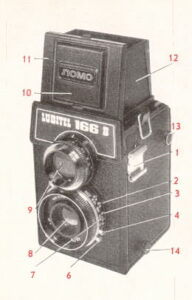 |
Figs I–5 show main camera parts.
1–block for fixing accessories; 2–diaphragm scale indicator; 3–diaphragm scale; 4–flash shoe; 5–lever of the shutter speed adjusting ring; 6–self timer lever; 7–exposure scale; 8–photographic lens; 9–viewfinder lens; 10–plate; 11–front frame; 12–light protective hood; |
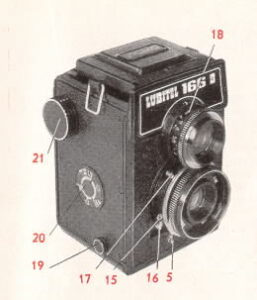 |
13–take-up spool spindle head;
14–supply spool spindle head; 15–shutter release lever; 16–cable release socket; 17 –shutter winding lever; 18 –distance scale; 19 –supply spool spindle head; |
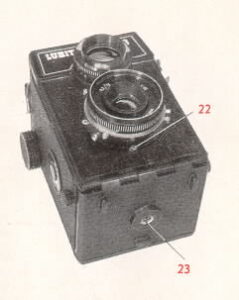 |
20 –reminder dial;
21 –film rewinding knob; 22 –diaphragm control lever; 23 –tripod nut; 24 –field lens; |
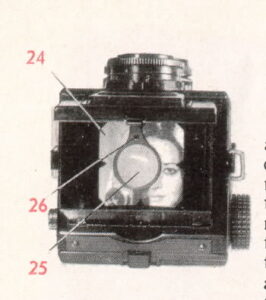 |
25 –ground glass circle;
26 –folding focusing magnifier; 27 –viewfinder cover lock; |
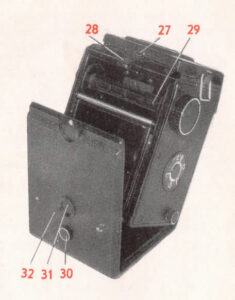 |
28 –camera back lock
29 –take-up spool; 30 –window cover plate head 31 –window; 32 –back. |
The reflex viewfinder consists of the viewfinder itself and a ground glass representing a small circle in the center of field lens with a folding focusing magnifier mounted above it. The viewfinder is provided with metal light protective hoods that open simultaneously with raising the cover. The viewfinder should be closed by the following procedures: first close the magnifier, then the side hoods, the rear hood with a square window and at last the cover until its front frame lug catches with the viewfinder case lock catch.
Focusing the images on the ground glass circle and in film plane is performed simultaneously as both lenses are coupled with each other with knurled mounts.
The focusing magnifier is attached to the panel from inside. The magnifier is set to operation by pulling it up from the cover.
The frame viewfinder is formed by the front frame and rear light protective hood with a square window. To open the viewfinder it is necessary to tilt the panel inside so that it catches the rear hood lug. Slightly pulling out the rear hood is enough to close the viewfinder.
To determine frame limits the camera should be held at eye level, the object should be observed through the square window in the Tear hood keeping the camera at the distance when the window edges coincide with those of the square opening in front frame. In this case the limits of the viewfinder field will be the frame limits.
The distance scale is graduated at viewfinder lens mount in meters.
Diaphragm shutter is automatically giving the following speeds: 1/250, 1/125, 1/60, 1130, 1/15 s. With shutter set to B
any manual-control shutter speeds are obtainable. Selected exposure time is set by rotating the adjusting ring lever 5
(fig. 2) to coincide the ring edge index with required exposure value (mean exposure is not obtainable with index intermediate positions).
Before shooting it is necessary to wind the shutter-rotating the winding lever fully downward. Shutter is released with smooth
pressing the release lever or the cable release the camera is provided with the socket for it. With shutter set to B index
it remains opened from the moment of pressing the release lever to its releasing.
To activate the self timer it is necessary to set the selected automatic exposure, wind the shutter, turn the self-timer lever 6 (fig. 1) fully downward and to press the release lever 5 (fig. 2). In 7–12 seconds the shutter will operate and the picture will be taken.
Remember that with shutter set to B and release lever pressed it is impossible to wind the self-timer lever.
Flash synchronizer is intended for matching the flashing moment with complete shutter opening.
With electronic flash used the shutter may be set to any automatic exposure. With flash bulb used the shutter should be set to 1/15 or B. On releasing the shutter the synchronizer will act automatically.
The diaphragm serves for the control of light opening diameter. The stopping down is performed by moving the lever 22 (fig. 8) with pointer 2 (fig. 1)
The lens is stopped down when increase of the depth of field is desirable or when the available light is too intensive. Photographic lens depth of fields with different diaphragms and distances are given in the table.
At exposure scale every following value is two times proceeding one. The diaphragm is f-numbered in such a manner that the pointer moving to a stop two times increase or decrease the amount of light for exposure. For instance the exposure time is 1/60 second at f 5.6 and if the lens has been stopped down to f/8 in other equivalent conditions the shutter should be set to 1/30 second.
Exposures and renumbers carry the denominators only, as all instead of 1/15, a4.5~ instead of 1/4.5 and so on.
The diaphragm and distance scales between figures 8 and 11 are marked with white dots. With diaphragm scale pointer and distance scale index set to these dots all the images of objects at a distance of 45 m to infinity arc obtained share.
5. CAMERA OPERATION PROCEDURES
5.1. Loading the Camera
Taking the camera in your left hand, open the camera back pulling off preliminarily the lock spring.
Turning the film rewinding knob 21 (fig. 2), bring the spool slot at position convenient for loading the film protective paper end.
Fully pull off the both heads of the supply spool spindles. Break the seal of the film protective paper and insert the spool with the film into the body receptacle between the spring and the body wall having pressed the flat spring with your finger. Pressing the supply spool with your finger insert to it both spindles by pressing their heads.
Unwind the end of the protective paper and on folding it down for about 10 mm insert in the slot of the take-up spool. Then holding the spool with the film with your left finger and rotating the film rewinding knob wind 2–3 layers of the protective paper to the take-up spool. Close the camera back assured that the paper tension is good.
Having turned anticlockwise the window cover plate head 30 (fig. 5) rotate the film rewinding knob 21 (fig. 2) until first the signal marks on protective paper and then c1~ appear in the window. Close the cover plate.
5.2. Taking Pictures
Before taking pictures, set the required exposure time and diaphragm. Exposure is set on exposure scale by rotating exposure adjusting ring dog 5 (fig. 2). The required diaphragm value is set by moving the lever 22 (fig. 3) with index along the scale.
Looking to the viewfinder determine the frame limits and with the focusing reach the required sharpness at the ground glass circle. If the object image that is required to get most sharp should be located at the picture edge turn the camera while focusing so that the object image was in the center find prior to the shutter release return the camera to the initial position.
With the winding lever I7 (fig. 2) wind the shutter and release it smoothly.
Pull the film at a frame length (immediately after taking picture not to forget). To do that open the window cover plate and rotate the film rewinding knob 21 till the following figure appears in the window, then close the cover plate.
5.3. Unloading the Camera
After the twelfth exposure has been made rewind at the take-up spool the film protective paper. Sometimes when the winding is almost completed the turning of the knob is detained due to the paper jammed in the supply spool slit. However this should not prevent the daylight unloading the camera.
Open the camera back.
Fully pull off the film rewinding knob and take-up spool head.
Carefully take but the spool with the exposed film, seal the protective paper end and keep the film until it is developed.
Having pulled off the heads of the supply spool spindles as far as they will go, take the spool out of its receptacle and insert into that of the take-up spool. Further slightly turning the film rewinding knob, press it and the head of the take-up spool spindle up to the stop.
Close the camera back.
6. MAINTENANCE Handle the camera with care.
Contaminated lenses deteriorate pictures sharpness, so it is necessary to keep lenses always clean. The objective lenses could be wiped from the outside only using a clean cambric or linen cloth or cotton wool, on having breathed on them.
Never disassemble the camera.
Never wipe the plastic parts of the camera and the field lens with alcohol, acetone and other active solvents.
7. ACCEPTANCE CERTIFICATE
The camera Lubitel 166B of serial number xxxx meets the technical requirements and is found fit for operation.
Production date 08/09/1980

